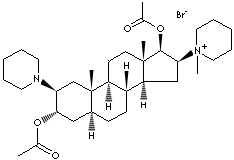PRODUCT IDENTIFICATION
50700-72-6 (bromide)
63884-29-7
72254-12-7
74531-67-2

H.S. CODE
TOXICITY
CLASSIFICATION
PHYSICAL AND CHEMICAL PROPERTIES
REFRACTIVE INDEX
NFPA RATINGS
AUTOIGNITION
FLASH POINT
EXTERNAL LINKS & GENERAL DESCRIPTION
Monoquaternary homolog of PANCURONIUM. A non-depolarizing neuromuscular blocking agent with shorter duration of action than pancuronium. Its lack of significant cardiovascular effects and lack of dependence on good kidney function for elimination as well as its short duration of action and easy reversibility provide advantages over, or alternatives to, other established neuromuscular blocking agents. Vecuronium bromide is a competitive non-depolarising muscle relaxant that came onto the market in 1980, as an alternative to pancuronium. The duration of action is not as long as that provided by a comparable dose of pancuronium. Vecuronium is slightly more expensive than pancuronium, but generates even less histamine release, and produces few or no adverse cardiovascular effects. It is rapidly taken up by the liver and partially metabolised prior to excretion, largely in the bile. Some of the metabolites, such as 3-desacetyl-vecuronium, which retain considerable neuromuscular blocking activity, are mostly excreted in the urine. (http://www.blackwellpublishing.com/)
Vecuronium is a bisquaternary nitrogen compound that acts by competitively binding to nicotinic cholinergic receptors, preventing confirmational changes. The binding of vecuronium decreases the opportunity for acetylcholine to bind to the nicotinic receptor at the postjunctional membrane of the myoneural junction. As a result, depolarization is prevented, calcium ions are not released, and muscle contraction does not occur. (http://www.healthsystem.virginia.edu/)
Neuromuscular blockers relax skeletal muscle tone by blocking transmission of key neurotransmitters through the neuron receptors at the neuromuscular junction (NMJ). They are divided into two major categories, depolarizing and non-depolarizing neuromuscular blockers, corresponding to the manner in which they exert their therapeutic effect. Depolarizing neuromuscular blocking agents mimic the effects of the neurotransmitter acetylcholine (ACh) and change the interaction between ACh and neuron receptors. Blockade occurs because membranes surrounding the neuromuscular junction become unresponsive to typical ACh-receptor interaction. Non-depolarizing neuromuscular blockers bind to receptors to prevent transmission of impulses through ACh neurotransmitters. Neuromuscular blockers are primarily used in a clinical or hospital setting. In the United States, they are known by several generic and brand names, including atracurium (Tracurium), cisatracurium (Nimbex), doxacurium (Neuromax), mivacurium (Mivacron), pancuronium (Pavulon), pipecuronium (Arduan), rocuronium (Zemeron), succinylcholine (Anectine), tubocurarine, and vecuronium (Norcuron). (http://www.healthline.com/)
Pharmacological Actions:
- Cholinergic antagonist
- Neuromuscular agent
- Neuromuscular blocking agent
- Neuromuscular nondepolarizing agent
- Neurotransmitter agent
- Nicotinic antagonist
- Peripheral nervous system agent
|
Neuromuscular blockers |
|
| Product | CAS RN. |
| Alcuronium | 23214-96-2 |
| Atracurium | 64228-79-1 |
| Atracurium Besylate | 64228-81-5 |
| Boldine | 476-70-0 |
| Cisatracurium | 96946-41-7 |
| Cisatracurium Besylate | 96946-42-8 |
| Curare | |
| Decamethonium | 156-74-1 |
| Domoic Acid | 14277-97-5 |
| Doxacurium Chloride | 106819-53-8 |
| Ethylcholine Aziridinium | 63918-37-6 |
| Gallamine Triethiodide | 65-29-2 |
| Gallamine | 153-76-4 |
| Glycopyrrolate | 596-51-0 |
| Grayanotoxin I | |
| Metocurine | 5152-30-7 |
| Metocurine Iodide | 7601-55-0 |
| Mivacurium | 106791-40-6 |
| Mivacurium Chloride | 106861-44-3 |
| Neosaxitoxin | 64296-20-4 |
| Pancuronium Bromide | 15500-66-0 |
| Pipecuronium | 68399-58-6 |
| Pipecuronium Bromide | 52212-02-9 |
| Pyrantel | 15686-83-6 |
| Rapacuronium Bromide | 156137-99-4 |
| Rocuronium | 143558-00-3 |
| Rocuronium Bromide | 119302-91-9 |
| Succinylcholine | 306-40-1 |
| Succinylcholine Chloride | 71-27-2 |
| Sugammadex Sodium | 343306-79-6 |
| Taipoxin | 52019-39-3 |
| Toxiferine | 302-30-7 |
| Tubocurarine Chloride | 6989-98-6 |
| Tubocurarine | 57-95-4 |
| Vecuronium Bromide | 50700-72-6 |
| Vesamicol | 22232-64-0 |
APPEARANCE
ASSAY
99.0 - 101.0%
1.0% max
HEAVY METALS
10ppm max
4.5% max